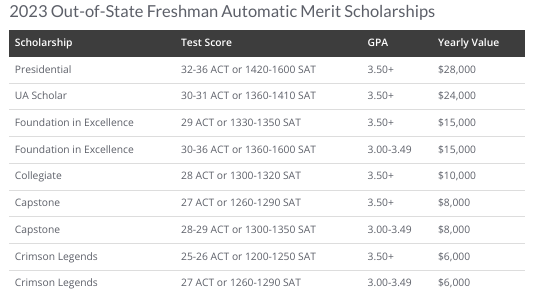This is part 2 of a 3-part series on College + Money, and you can learn more about this topic and also hear last week’s “College Costs Simplified” on the Tom Talks College podcast.
Merit aid may be the best thing you’ve never heard of when it comes to college admissions, and what follows is a quick introduction to what could be your teen’s best part-time job…and to the gift that keeps giving. Before we dig into the details, let me state this up front and as clearly as I can.
Merit aid is the best tool you have to reduce the cost of college.
Read that again, and if it helps, imagine me as Curly from “City Slickers” holding up one finger to you, the Billy Crystal character, but not dodging your question about what the one thing is – because it’s merit aid. Plain and simple.
What exactly is merit aid?
Merit aid is a general term for scholarships you earn that come directly from colleges. You’ll sometimes see these listed as freshman scholarships, and they are awarded for talents such as athletics, fine arts, or academic achievement. Just as important is what they are NOT. Merit scholarships are NOT:
- Loans;
- Need-based financial aid;
- Distributed by the federal government.
The bulk of merit aid is “automatic”, in that it’s awarded by hitting key benchmarks in cumulative GPA and ACT/SAT scores. (By comparison, “competitive” scholarships are those to which you apply after acceptance and are usually awarded to only a handful of students. If you see a long list of scholarships with the donors’ names attached, those are competitive.)
For academic merit aid, admissions offices pull GPA and ACT/SAT numbers, if applicable, straight from your student’s application, and many colleges openly display what I call a “merit matrix” – a simple chart with rows and columns for grades, test scores and money. The first example I saw was on Miami University’s website, and I almost fell off my chair.
The gift that keeps giving
Unlike scholarships that are handed out at high school awards nights, merit aid is awarded all four years assuming the student maintains satisfactory grades.
You, the hard-working, bright high school student, spend three years building up that nice GPA and knocking out some impressive standardized test scores – and you’ll be handsomely rewarded throughout four years of college.
Where and how to find it
In general, you’ll find merit aid in two types of colleges:
- Public universities in states hoping to attract bright young minds and boost not only the academic stats of an incoming class, but their ranking in US News and World Report.
- Private colleges and universities that aren’t members of the Ivy League or among the most highly selective.
The first category is a little easier to find and often comes with a merit matrix. The second category is less evident and less likely to be upfront about automatic merit aid, but it’s still a prime source of merit aid.
There is no central database or comprehensive list of colleges that award merit aid, so your best bet is to Google [name of college] and then a combination of these terms: merit aid, merit scholarships, freshman scholarships.
I often plug out-of-state into my search, because I’m usually searching for options beyond a student’s home state. Be sure to compare in-state vs. out-of-state merit when you find it, because those numbers can vary greatly.
Example of a merit matrix
Here’s a great example of a merit matrix at the University of Alabama.
Notice there are two levers: cumulative GPA and ACT/SAT. Alabama uses two GPA ranges (3.50+, 3.00-3.49) which is fairly common. Sometimes you’ll see one level stacked on top of the next, i.e. 3.50 + 26 ACT, 3.75 + 28 ACT, 4.00 + 30 ACT. And in full transparency from a business which was built on test prep, some colleges shifted to a GPA-only approach in 2020 so you really do need to look at each college individually.
Why are they doing this? Is there a catch?
Way before NIL, colleges aggressively recruited 5-star athletes to boost on-field success – and some have taken a similar approach to academics. A seminal article on the merit aid movement was published in the New York Times on November 3rd, 2016: How the University of Alabama Became a National Player.
Rule of thumb for merit aid
The harder it is to get into a college, the less likely you are to get merit aid. Their gift to you is the fat envelope. The Ivy League doesn’t award merit because they don’t have to, and neither do the hyper-popular-and-competitive public flagships like UNC-Chapel Hill. In fairness, they do offer some but I’ll let you read this and then decide what your chances are.
UNC is proud to offer Academic Scholarships to a small number of outstanding students each year. All students who are admitted to UNC are automatically considered for these scholarships; no additional application materials are necessary.
Unfortunately you’ll quickly run into colleges which don’t offer merit aid, or are much less transparent, using language to the effect of “we provide scholarships for deserving students in recognition of their achievements.” “ (On a future podcast and blog I’ll coach you on how to use Net Price Calculators as a possible work-around.)
Great values beyond flagships
Medium-sized private universities that accept over half of applicants are a great source of merit aid. Marquette, for example, almost always knocks off a quick $16,000-$20,000 in the acceptance letter. Regional comprehensive universities similar to UW-La Crosse or Winona State also offer tremendous value. The snowboarder or mountain bike enthusiast who ventures to Colorado Mesa University in Grand Junction packing a 3.75 and a 29 ACT will be rewarded with $6000/year, and that’s coming off an already low out-of-state tuition and fees cost of $15,000 after CMU shows you some love with their tuition discount programs.
Seriously…if your kid digs the Colorado thing, especially that corner over by Utah, New Mexico and Arizona…why wouldn’t you take a hard look at Colorado Mesa?
Your teen’s best part-time job
I wrote that phrase – your teen’s best part-time job – not to suggest that 16-year-olds shouldn’t bag groceries or mow lawns or be a nanny. I just want to be painfully clear that efforts and achievements in the classroom can have tremendous potential ROI, and should be taken as seriously as the time spent working, playing sports or practicing the oboe.
It’s not my goal to put pressure on your kid to be a 4.0 student. I just want them to understand that grades and test scores don’t just happen, and sometimes a small amount of effort or just attention to detail makes a big difference. The billboard I’d put up has a simple message that all students can achieve.
Turn in all your homework. On time. All the time.
I’ll skip the $8000 German take-home vocabulary quiz story mentioned on the podcast.
Merit aid is real and it’s within your reach
For the vast majority of students, a merit scholarship based on academics is far more likely than an athletic, music or theater scholarship, and probably reduces your costs of higher education significantly more. So know what matters to colleges in terms of admissions but also in terms of merit aid, and let your student know early on. We did this with both our sons when they were in middle school, and both earned merit scholarships for out-of-state public universities that saved them and us tens of thousands of dollars.
Having a conversation beyond the numbers
If you’re struggling with any part of this – or if you just want to talk to someone who thinks about this everyday – email me anytime or schedule a free consult and let’s talk not just about the numbers, but about your family and your students, and what you hope to achieve.



Recent Comments